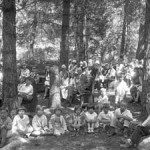The Idyllwild Water District commissioned a study of the possible effects if the Foster Lake Dam were breached. The study was completed in July and submitted to the California Office of Emergency Services, which accepted it Nov. 1.
Following the failures at the Oroville Dam in February 2017, the state Legislature enacted requirements for all dams within the state to be reassessed. The current IWD “Inundation Study” complies with this legislation.
“I’m very comfortable with the reliability of the dam,” said General Manager Jack Hoagland. “It’s in good shape and we actively maintain it.”
IWD stores water in Foster Lake. Lily Creek flows directly into the lake and water also is diverted from Strawberry Creek into the lake. Foster Lake was originally permitted in 1944 for a 40-acre-feet capacity. The report says its current capacity is 180 acre-feet.
“Foster Lake is contained behind the dam facilities that include an earthen dam to the south and west, and a concrete spillway to the south, says the authors of the technical study. “If a breach were to occur at the Foster Dam, the steep terrain found on the downstream side of the dam would cause the flood wave to have a high initial velocity due to the rapid change in elevation from the point of the breach to the downstream areas of concern.”
If the dam, which was built in 1945, were breached, water would flow down Lily Creek under, and, depending upon the volume, possibly over Highway 243. The creek passes between the Idyllwild Nature Center and the back of several Cedar Glen properties into the Idyllwild County Park. Lily Creek flows into Strawberry Creek before passing under the bridge on Delano Road. Strawberry Creek continues to Idyllwild Arts Academy and then down the Hill to the North Fork of the San Jacinto River.
The biggest risk of an earthen dam is overtopping, according to the study. Engineering Resources of Southern California, which prepared the study, said “the limits of flood inundation has the potential to inundate a few structures and roadways along the flood path,” depending upon the volume of water released from the dam.
Hoagland said his biggest concern is communication of an emergency. The next step is preparing an emergency action plan, which Cal OES would like to have by Jan. 1, 2019, but which hasn’t been started.
Preparation of the plan is identifying the property owners below the dam at risk of potential flooding and how to contact them in an emergency. However, Hoagland noted that over time, houses can be sold and new owners have to be contacted. Keeping the names and contact numbers current will be the long-term issues.
Hoagland emphasized that the dam and nearby shore are maintained thoroughly throughout the year. Removal of vegetation, rodent control, particularly gophers, and equipment replacement are conducted regularly.
The California’s Division of Safety of Dams, an agency in the Department of Water Resources, conducts annual inspections and has passed the Foster Lake Dam. “They make suggestions and we implement them,” Hoagland said.
The last “Inundation Study” was conducted in 1974 and this study cost IWD $68,000. In November 2017, when the board approved the contract for this study, IWD Vice President Peter Szabadi recommended that the 1974 study be submitted since “… where the water will go should the dam fail has not changed.”
While it was approved, President Dr. Charles “Chip” Schelly abstained from voting for or against conducting the analysis.
Preparation of a new emergency action plan is the next step for the board, which has not discussed the report since its preparation in July or its acceptance in November.










